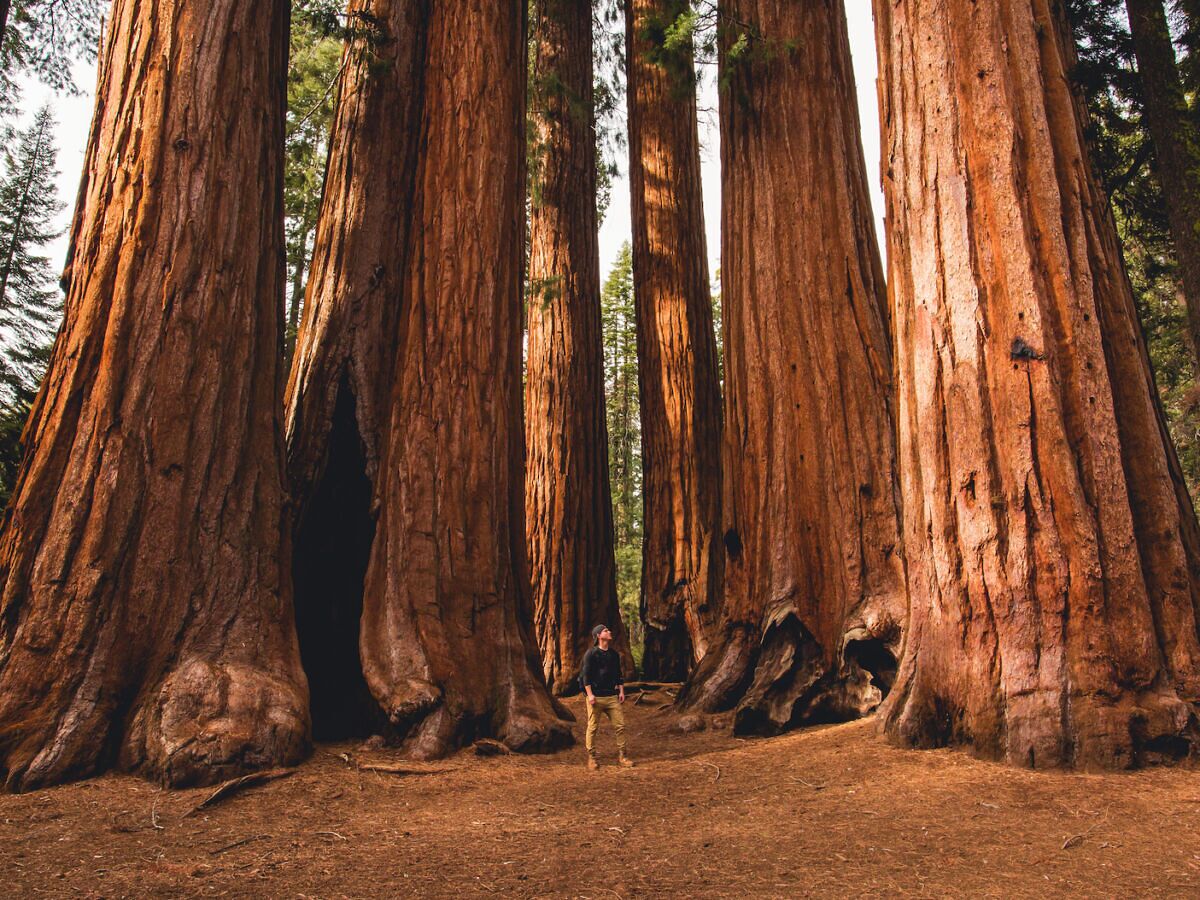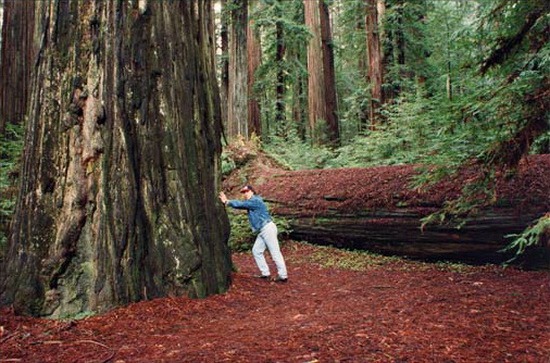Contents
The Stratosphere Giant, a remarkable specimen of the Coast Redwood species (Sequoia sempervirens), stands as a testament to the awe-inspiring grandeur of nature’s tallest trees. Located amidst the ancient forests of California, USA, this majestic giant reaches dizzying heights, captivating the imagination of all who encounter it. Let’s embark on a journey to discover the remarkable story and enduring legacy of the Stratosphere Giant.

Stratosphere Giant
Origins and Habitat:
The Stratosphere Giant, like its fellow Coast Redwoods, traces its roots back to the misty coastal regions of Northern California and southwestern Oregon. These towering trees are renowned for thriving in the fog-shrouded valleys and nutrient-rich soils of the Pacific Coast, where they have flourished for thousands of years, bearing witness to the passage of time and the changing landscape.
Tower of Height:
What sets the Stratosphere Giant apart is its extraordinary height, which ranks among the tallest trees on Earth. Standing at an impressive approximate height of 370.4 feet (113 meters), the Stratosphere Giant pierces the canopy with its towering presence, reaching towards the heavens with unparalleled majesty. Its colossal stature commands attention and inspires reverence, serving as a living testament to the resilience and adaptability of the Coast Redwood species.
Guardian of the Forest:
As a towering sentinel in the ancient redwood forests, the Stratosphere plays a vital role in its ecosystem, providing habitat and sustenance for a diverse array of flora and fauna. Its towering canopy shelters an intricate web of life, from mosses and ferns to birds and mammals, contributing to the biodiversity and ecological balance of the forest ecosystem.
Cultural Significance:
The Stratosphere Giant, like other Coast Redwoods, holds cultural significance for indigenous communities and environmental advocates who recognize the importance of preserving these ancient giants for future generations. These majestic trees embody the spirit of resilience, endurance, and interconnectedness, serving as symbols of strength and vitality in the face of environmental challenges.

Stratosphere Giant
Conservation Efforts:
Despite their remarkable resilience, Coast Redwoods face threats from human activities such as logging, urbanization, and climate change. Conservation efforts aimed at protecting old-growth forests, establishing protected areas, and promoting sustainable forestry practices play a crucial role in safeguarding the habitat of the Stratosphere Giant and its fellow redwoods for generations to come.
Visiting the Giants:
For those fortunate enough to visit the ancient redwood forests of California, experiencing the awe-inspiring presence of giants like the Stratosphere Giant is a humbling and unforgettable experience. Walking among these towering sentinels, with their soaring heights and timeless beauty, fosters a deep appreciation for the natural world and reinforces the importance of conservation and stewardship.
The Stratosphere Giant stands as a towering testament to the majesty and resilience of the Coast Redwood species, embodying the awe-inspiring beauty of nature’s tallest trees. As a guardian of the forest, it serves as a beacon of hope and inspiration, reminding us of the importance of preserving ancient forests and safeguarding biodiversity for future generations to cherish and enjoy. In the embrace of the Stratosphere Giant, we find solace, wonder, and a profound connection to the natural world.
Exploring the Pros and Cons of the Stratosphere Giant: A Remarkable Coast Redwood
The Stratosphere Giant, a towering exemplar of the Coast Redwood species (Sequoia sempervirens), commands attention with its majestic stature and awe-inspiring presence. As one of the tallest trees on Earth, this magnificent specimen captivates admirers and researchers alike. However, like all natural wonders, the Stratosphere comes wdbos with its own set of advantages and disadvantages. Let’s delve into the pros and cons of this remarkable tree.

Stratosphere Giant
Advantages of the Stratosphere Giant:
- Towering Stature: Standing at approximately 370.4 feet (113 meters), the Stratosphere Giant is among the tallest trees on the planet. Its towering height symbolizes the resilience and grandeur of the Coast Redwood species, inspiring awe and reverence among visitors and conservationists.
- Biodiversity Support: As a prominent feature of the ancient redwood forests, the Stratosphere Giant provides habitat and sustenance for a diverse array of plant and animal species. Its towering canopy shelters mosses, ferns, lichens, and epiphytes, while also serving as nesting sites for birds and refuge for small mammals.
- Carbon Sequestration: Mature redwood trees like the Stratosphere Giant play a crucial role in mitigating climate change by sequestering carbon dioxide from the atmosphere through photosynthesis. Their massive trunks and extensive root systems store significant amounts of carbon, helping to offset carbon emissions and combat global warming.
- Cultural Significance: The Stratosphere Giant, along with other Coast Redwoods, holds cultural significance for indigenous communities, environmental advocates, and nature enthusiasts. These majestic trees inspire a sense of wonder and connection to the natural world, fostering appreciation for old-growth forests and the importance of conservation efforts.
Disadvantages of the Stratosphere Giant:
- Vulnerability to Environmental Threats: Despite their resilience, Coast Redwoods, including the Stratosphere Giant, face threats from human activities such as logging, urban development, and climate change. Habitat loss, fragmentation, and alteration pose significant challenges to the long-term survival of these ancient giants and the ecosystems they support.
- Limited Geographic Range: The natural range of Coast Redwoods is limited to the fog-shrouded coastal regions of Northern California and southwestern Oregon. The restricted geographic distribution of these trees makes them vulnerable to localized threats and limits their potential for range expansion in response to changing environmental conditions.
- Slow Growth Rate: While Coast Redwoods are renowned for their towering heights, they have relatively slow growth rates compared to other tree species. The growth of the Stratosphere Giant and its counterparts is measured in centuries rather than decades, making them susceptible to long-term environmental changes and disturbances.
- Management Challenges: Managing and conserving old-growth redwood forests, including the Stratosphere Giant’s habitat, presents numerous logistical and regulatory challenges. Balancing conservation priorities with human needs and economic interests requires cooperation among stakeholders, policymakers, and conservation organizations.
Conclusion:
The Stratosphere Giant stands as a towering symbol of the majesty and resilience of the Coast Redwood species. While its remarkable height and ecological importance are undeniable, challenges such as habitat loss, climate change, and management complexities underscore the need for proactive conservation efforts. By recognizing the advantages and addressing the disadvantages associated with the Stratosphere Giant and its fellow redwoods, we can work together to ensure the preservation of these ancient giants for future generations to admire and cherish.
Read More Article About “DUBAI FLOODING: UNDERSTANDING THE IMPACT AND RESPONSE 2024“





